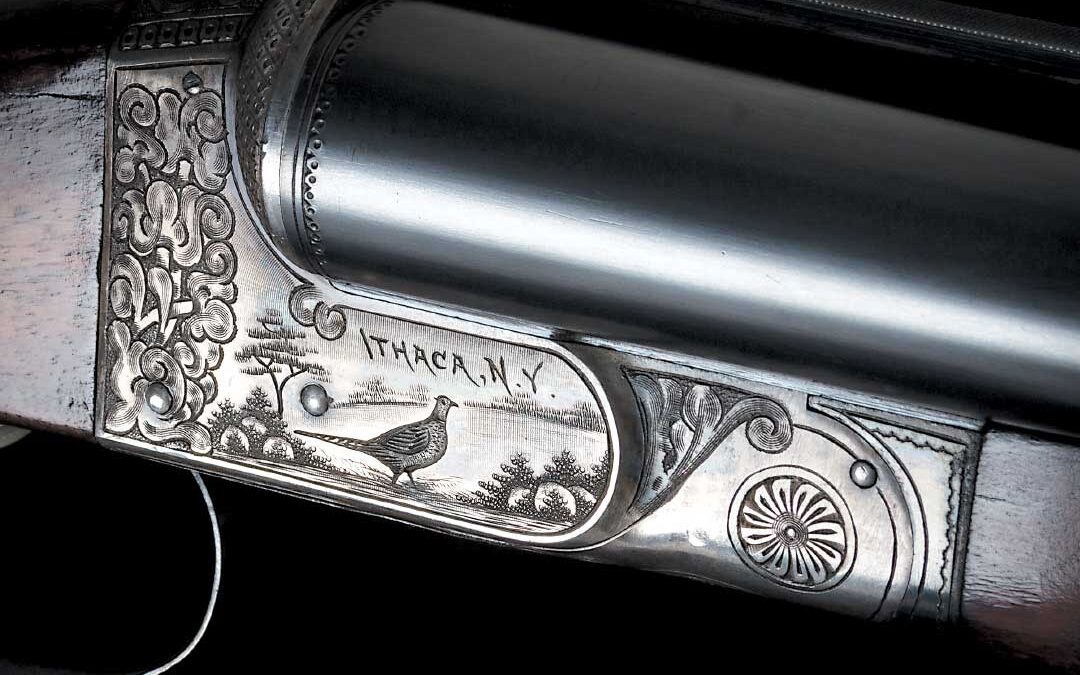Like many enterprises of the time, its origins were humble. It began in a rough little wooden structure perched precariously on the steep gorge of Fall Creek near Ithaca, New York. The virtue of the location was its abundant water power, and the building had already been a mill and wagon spoke shop by the time it was purchased to build guns. In 1880, the first of a distinguished line of Ithaca double shotguns emerged from the dim, oil-lighted recesses of the tiny factory.
During the next 68 years, the company grew and the name Ithaca became synonymous with double barrel guns of high quality, sturdy construction and careful workmanship. In an unrelenting quest for improvement and in an effort to provide the American hunter with the best possible gun at reasonable prices, Ithaca doubles underwent five distinct changes in design before shifting market conditions and rising manufacturing costs forced the company to discontinue its entire line of doubles. By 1948, Ithaca had joined other respected American makers of fine side-by-side guns as casualties of the times.
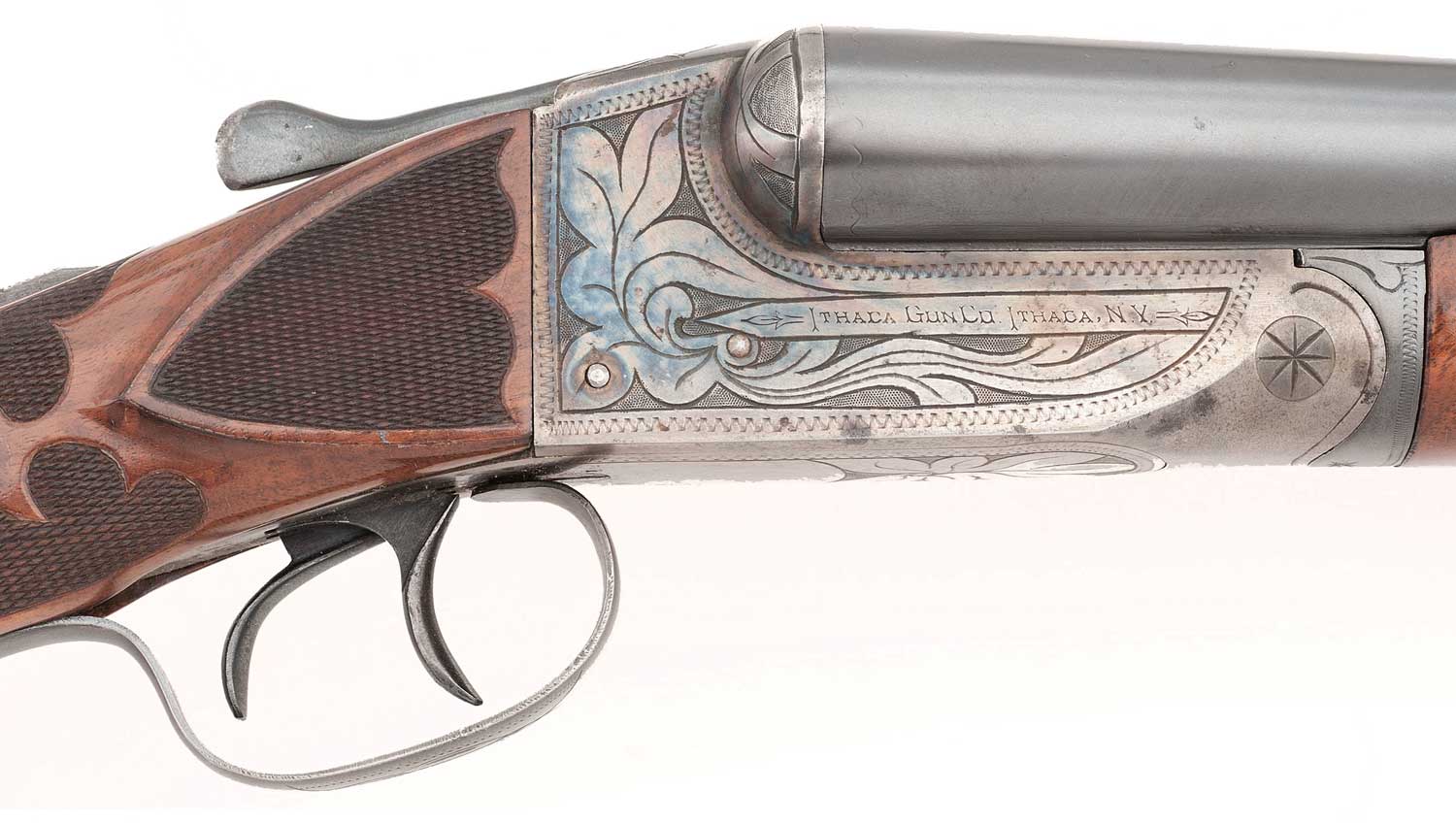
Leroy H. Smith was the force behind the founding of the Ithaca Gun Company. A successful businessman from Lisle, New York, he became intrigued with the possibility of manufacturing a shotgun designed by W. H. Baker, a local gunsmith. A skillful workman, Baker’s handmade guns had earned him a good reputation among the residents of the area. His earlier designs included a three-barrel gun with two shotgun and one rifle barrel, but it was Baker’s design for an improved double barrel hammer shotgun that impressed Smith.
Baker’s design departed from convention. It was a boxlock action with hammers mounted at the extreme rear of the receiver in contrast to the usual practice of employing sidelocks on external hammer guns. The Baker double locked with an underbolt and a doll’s head extension on the barrel rib. Equipped with the design and $1,800 in capital, Smith set out to produce the Baker double. The Ithaca Gun Co. was born.

The Baker Model contributed substantially to Ithaca’s early success and reputation as a maker of sturdy doubles that met the needs of American sportsmen. Early advertisements proclaimed the Baker Model Ithaca to be the “Strongest, simplest and best American gun manufactured.”
Nevertheless, among American shooters the trend to hammerless doubles had begun in earnest. In 1892, Ithaca introduced a hammerless gun designed by Fred Crass, a toolmaker employed by Ithaca. Production of the Crass Model Ithaca began at serial number 17,235 and continued through number 94,108 in 1903, the final year of production.

Damascus or twist barrels were standard for the times, but along with the trend to hammerless guns, a shift to the use of stronger fluid steel for barrels occurred during the years just after the turn of the century. Company sources place the introduction of fluid steel barrels on Ithaca guns around 1902, and the 1903 Ithaca catalog offers fluid steel barrels in addition to stub twist and Damascus.
The transition to fluid steel did not take place overnight, for many shooters still preferred the old construction, and Ithaca continued to offer twist or Damascus barrels on its guns for a number of years after the introduction of fluid steel. The 1916 catalog contains the last mention of the availability of Damascus and stub twist barrels.
If one were to analyze models by barrel type during these transition years, findings would probably show that some late manufactured Crass doubles were produced with fluid steel barrels and that the subsequent models of the Ithaca line—Lewis, Manier and Flues—were barreled both with modern fluid steel and with Damascus or twist. As time went by and demand for Damascus declined, it seems likely that an increasing percentage of these Ithaca models were fitted with fluid steel tubes.
Earlier Ithacas having barrels of modem steel are sometimes found. As late as the 1920s and ’30s the company would fit new steel barrels to its guns to replace the original twist or Damascus if the customer desired it.

Ithaca Knick 5E 12-gauge trap shotgun, manufactured in 1927.
In 1904, the Lewis Model Ithaca was introduced at serial number 94,109. Although the cocking mechanism remained essentially the same as the earlier Crass Model, the Lewis was the first Ithaca advertised as locking with a three-bolt system. Ithaca catalogs of the Lewis era show the locking arrangement employing two separate cuts in the barrel extension plus an underbolt.
By this time, the Ithaca line had become extensive. Hammer guns continued being offered for those who preferred them, and there was a model of hammerless gun to meet virtually every need, taste and pocketbook. The 1904 Ithaca catalog lists no fewer than nine hammerless models, including No. 1 Special, No. 1, 1 1/2, 2, 3, 4, 5, 6 and 7. All guns were available in 10, 12 or 16 gauge. Prices ranged from $37.75 for the No. 1 Special with Nitro Steel Barrels through $100 for a No.4 with “fine imported four-blade Damascus, Crown or Krupp fluid steel barrels, fine selected French walnut stock, rolled gold triggers, all metal parts beautifully engraved by hand with dogs, bird and game scenes.”
At the top of the line was the No. 7 Ithaca, described from the catalog as:
“The best imported Damascus or Whitworth Fluid Steel barrels money will buy, the best Italian walnut stock and fore end to be had, full pistol grip unless otherwise ordered, engraved skeleton butt plate, the most elaborate checkering and engraving, gold triggers and name plate, a gold dog inlaid on each side of frame, inlaid gold bird on bottom of frame; in fact, the best of everything and unequalled by any American or European guns at any price. 10, 12 and 16gauge…. List Price, $300.00.”
The Manier Model Ithaca, incorporating a different cocking mechanism than its predecessors, was introduced in 1906 at serial number 130,000. Somewhat shorter lived than the Lewis Model, the Manier was manufactured for only three years. In 1908 it was replaced by the Flues Model.
Emil Flues was a gunsmith employed by Ithaca to do research and development work. The Flues Model of 1908 introduced a refined bolting system incorporating tapered locking bolts, although the three-bolt design introduced with the Lewis Model was retained. The 1909 Ithaca catalog proclaimed the Flues to be “Our Improved Model,” and asserted it to be a gun that “will stand a lot of use and misuse.” The Flues proved to be a durable and long-lived model of the Ithaca line. Production began in 1908 at serial number 175,000 and ended in 1926 at serial number 398,365.
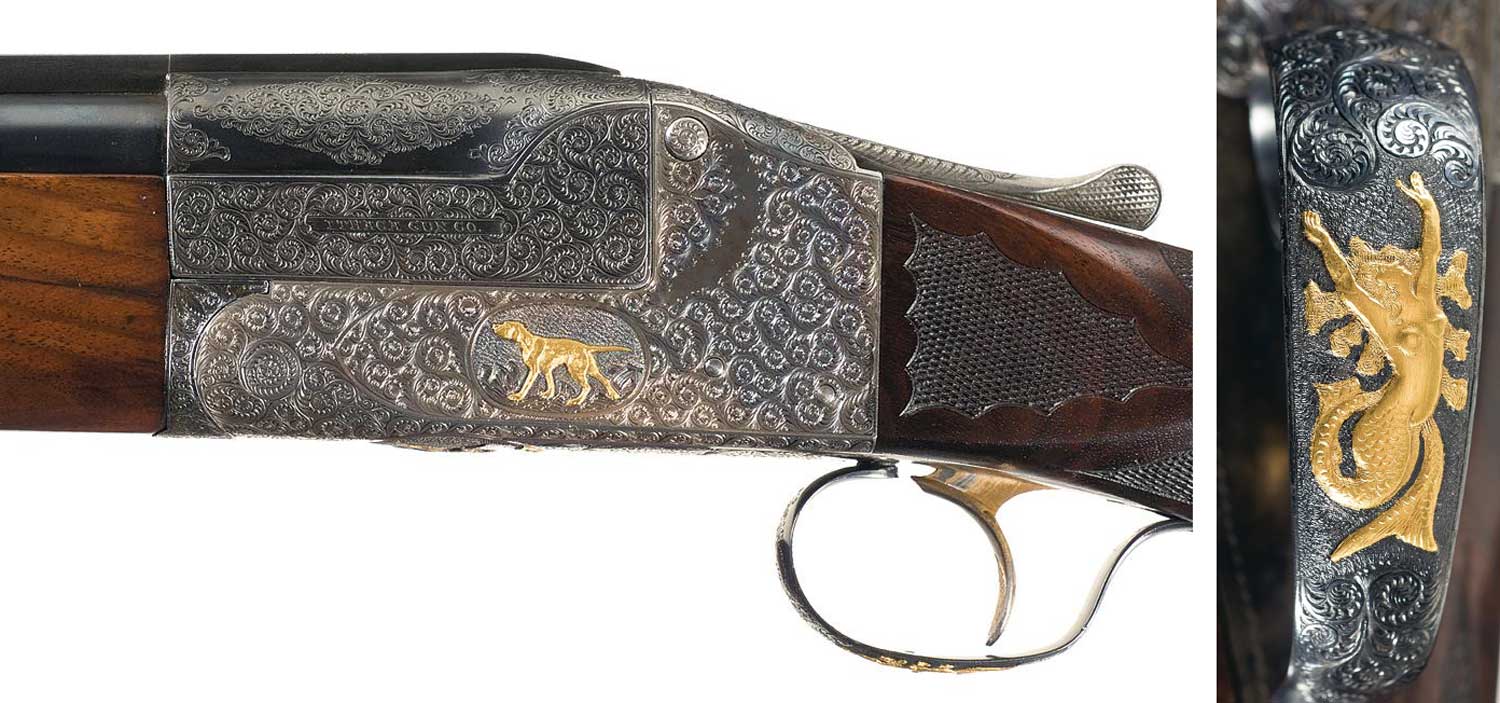
The most elaborately finished and expensive guns ever produced by Ithaca were the famous Sousa-grade guns, in honor of the great band leader and composer, John Philip Sousa. They were made in both single barrel trap and double barrel models. Typically, Sousas had a gold pointer and setter inlaid in either side of the action and sometimes an eagle or duck underneath the receiver. A gold mermaid, the hallmark of Sousa Ithacas, was inlaid on the trigger guard.
The Flues years witnessed the beginnings of the most elaborately finished and expensive line of doubles ever produced by Ithaca. These were the famous “Sousa-grade” guns, a designation bestowed by the company in honor of the great band musician and composer, John Philip Sousa. A dedicated trapshooter, Sousa regularly participated in national competitions. In 1918 he ordered a Flues Model single barrel trap gun with a specific request for a great deal of engraving. Ithaca’s master engraver Bill McGraw was responsible for embellishing the remarkable shotgun. The action was elaborately scroll engraved and at Sousa’s request a buxom mermaid inlaid in gold graced the trigger guard.
Sousa-grade Ithacas were made in both single barrel trap and double barrel models. Typically, Sousas had a gold pointer and setter inlaid in bas-relief on either side of the action and sometimes an eagle or flying duck underneath. The gold mermaid, hallmark of the Sousa Ithacas, was inlaid on the trigger guard.
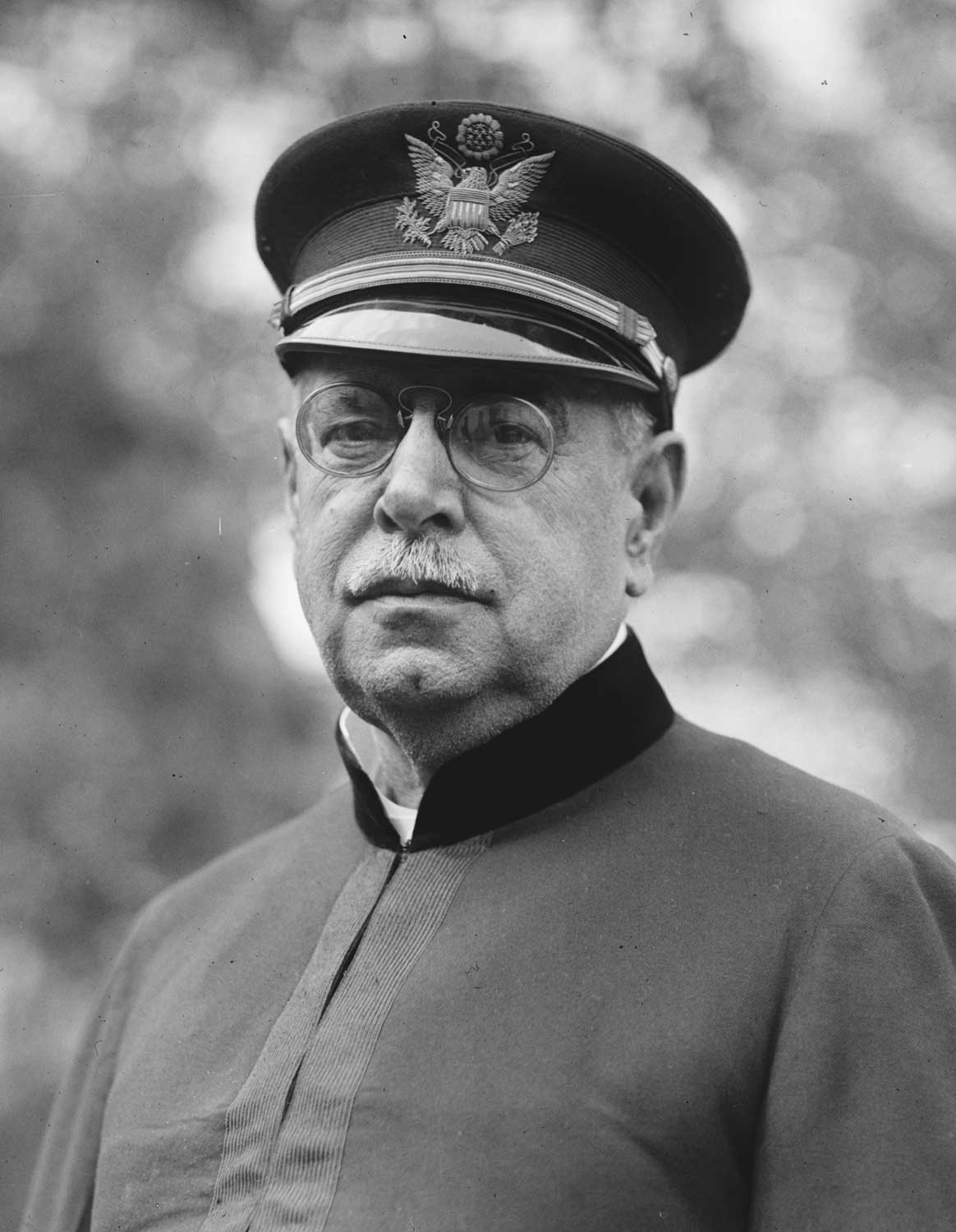
John Phillips Sousa
In the years that followed, a small number of Sousa-grade doubles were produced. Company sources indicate that three Flues Model Sousa doubles were made and 11 of the NID Model (New Ithaca Double), which was introduced in 1925. Twelve-gauge Sousas were the most popular. Of the 11 NID Sousa doubles made, 10 were 12gauge and one was .410 bore.
The 1918 catalog lists the Sousa double at $500. Prices rose steadily, and by 1934 the “Sousa Special” listed for $812.50.
Some years after the great band leader’s death, the Sousa designation was dropped. The highest grade double in the Ithaca line now became known by the price it commanded. Hence, the 1941 catalogues list the “$1,000 Grade Ejector,” and by 1946 it had become the “$1,500 Grade.” As manufacturing costs rose sharply in postwar years, the model went to $1,700 and finally to $2,000.
The NID Model represented the final design stage of Ithaca double guns. Introduced in 1925 at serial number 425,000 the NID differed significantly from earlier Ithacas in both cocking and bolting systems. The company’s first gun designed expressly for modem ammunition, the NID design replaced the “cocking hooks” of earlier models with rods connecting cams positioned in the forward part of the frame to the hammers.
The locking arrangement was also completely different. The underbolt was eliminated, leaving the frame stronger in this area. The barrel extension was redesigned to engage Ithaca’s new rotary crossbolt.
The NID Model served as the basis for Ithaca’s famous magnum doubles, introduced first in 10 gauge in 1932. Magnum doubles featured a somewhat larger and heavier frame as well as an additional locking lug through the bottom of the frame. Ithaca sources state only about 800 10-gauge magnums were made, with the remainder of the 1,000 serial numbers being applied to magnum 12-gauge guns.
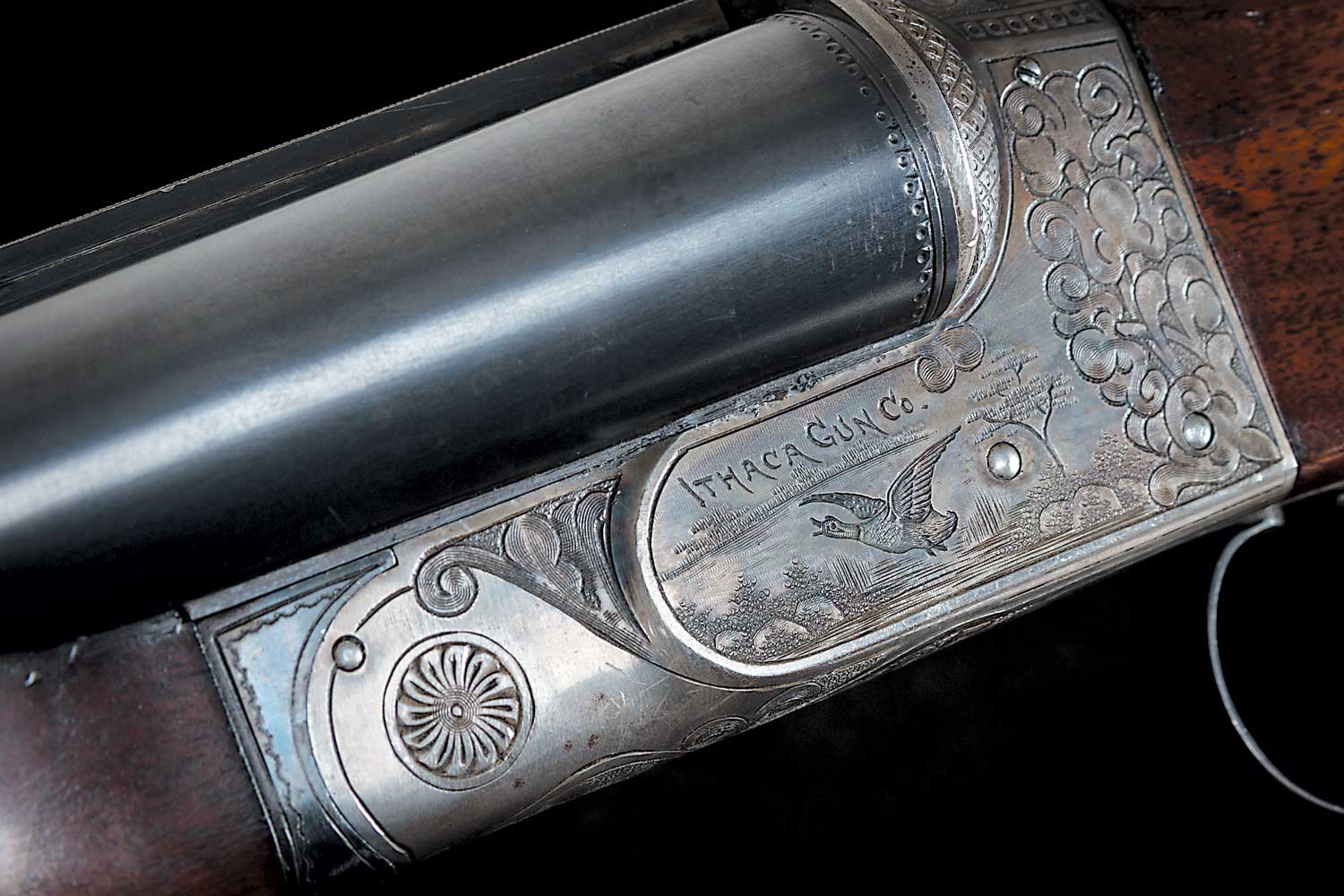
Ithaca NID 4E 12-gauge side-by-side shotgun, manufactured in 1926 Photos: Turnbull Restoration Co.
References to the speed of Ithaca locks are found frequently in Ithaca promotional literature of the Flues and NID periods. Ithaca lockwork was rugged and simple. The hammers traveled less than 1/2 inch and were very fast. Tests conducted at Cornell University confirmed hammer fall time to be only 1/625 of a second. Ithaca advertising often stated that a bird flying at 60 miles per hour would travel only about one inch during that time.
Ithaca doubles were frequently credited with excellent shooting qualities. Company advertising cited skillful barrel boring as the reason and gave much of the credit to “Uncle Bob” Edwards, a gentleman with a flowing white beard who had joined Ithaca after working with Baker. Edwards specialized in boring shotgun barrels. Referring to the shooting qualities of Ithaca guns, the noted firearms authority Elmer Keith wrote in his book Shotguns By Keith: “Both the old and the new models were superb shooting guns, in fact we have never seen better patterning guns, nor any guns shooting higher percentages in full choke than the Ithacas.”
Over the years, Ithaca Gun Co. absorbed a number of gunmaking firms including the Union Firearms Co., Syracuse Arms Co., Wilkesbarre Gun Co. and the Parry Firearms Co. The most notable of these was the Lefever Arms Co., acquired by Ithaca in 1915.
The Lefever name had long been associated with a distinguished line of high quality doubles, and Ithaca apparently assembled some of these guns from parts on hand during the years 1916-1917. According to current Ithaca sources, these Ithaca-assembled Lefevers numbered about 1,000.
In 1921, Ithaca introduced a new designed Lefever double of simplified boxlock construction. Known as the Nitro Special, it was made in gauges 12, 16, 20 and .410 and sold for substantially less money than the Field Grade Ithaca. Production of the Nitro Special began at serial number 100,000 and continued through serial number 361,199 in 1947. In 1935 Ithaca brought out the Lefever A Grade, a somewhat higher grade gun costing a bit more money. Options such as single triggers, beavertail forend, automatic ejectors, recoil pads and ivory sights were available on both models.
Other Lefever doubles were also offered by Ithaca, although apparently only for relatively short periods of time. The 1935 Lefever price list offers a “Model 4—Lefever Double Ventilated Rib Trap” gun, and in 1936 the company listed a “Model 6—Special Skeet Gun,” which was available in .410, 20, 16 or 12 gauges.
From 1929 through 1946 Ithaca also produced the modestly priced Western Arms Long Range Double. Similar in lockwork but differing in frame from the Nitro Special, the Western Arms Double could be ordered with optional auto ejectors and single trigger. In 1930 the gun sold for $20. Auto ejectors cost an additional $8.25.

Ithaca produced many beautifully embellished doubles, and no single man contributed more to that artistry than Bill McGraw, Ithaca’s master engraver for 62 years. His inlay work was notable for its use of pink, green and yellow gold, and much of his engraving included scenes of ducks and pheasants.
Probably the most famous of McGraw’s creations was the 12-gauge double Ithaca built in 1933 for King Faisal of Iraq. A gift from a group of Faisal’s American friends, this gun absorbed the energies of five gunsmiths for more than two months and cost more than $5,000. Decorated with embossed and inlaid scrollwork of 24-karat gold, the action bore the jewel encrusted design of the royal coat of arms. The stock was of highly figured burl walnut and decorated with carving.
Field grade Ithacas are much more numerous than high grade models, and someone wanting a good example of an Ithaca double is more apt to find one of these. Prices have risen dramatically from the old days, of course, when you could buy a Field Grade Flues for $32.50 (1918) or a Field Grade NID for $49.16 (1941). Herschel Chadick [then-Sporting Classics’ Firearms columnist], in response to a query from the author, put the price of an original NID Ithaca Field Grade with 50-60 percent blue and case colors at $400 to $500. Automatic ejectors might command an additional $200. [Prices quoted for 12-gauge guns in 1983 dollars].
Smaller gauges command more money and value accelerates rapidly as condition approaches mint. Ithaca prices have not reached the levels commanded by some other American doubles, but Ithacas are excellent guns, well worth the investment for collecting and shooting pleasure. As when they were new, Ithaca doubles continue offering good value for the money.
Detailed analysis confirms the abundance of Field Grade NID Ithacas in comparison to higher grade models. Company records indicate that only 560 No. 4 Grade Ithacas were produced, and only 22 No. 7 Grade guns. Small gauge NID doubles are also scarce even in Field Grade, for only 295 28-gauge guns were produced in this lowest priced model. Ithaca sources show that 790 Field Grade NID .410 doubles were made. High grade small gauge NID guns are just plain rare.
Well-made and dependable, Ithaca doubles met the needs of American sportsmen for nearly 70 years. It is to Ithaca’s credit that its reputation has lived on long after the double guns themselves have vanished from the dealer’s racks.
This article originally appeared in the November/December 1983 issue of Sporting Classics.

